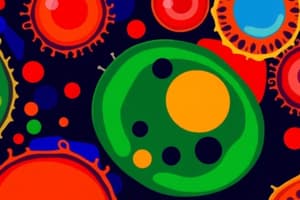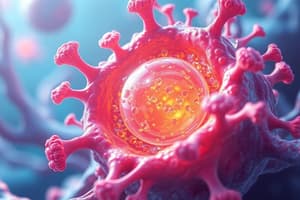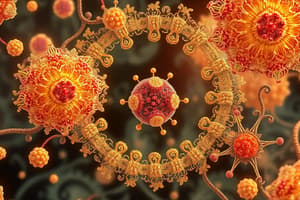Podcast
Questions and Answers
What percentage of a cell's dry weight do proteins typically comprise?
What percentage of a cell's dry weight do proteins typically comprise?
- 10-30%
- 35-50%
- 90-99%
- 55-85% (correct)
Which of the following molecules is NOT considered an organic compound found in cells?
Which of the following molecules is NOT considered an organic compound found in cells?
- Sodium chloride (correct)
- Fatty acids
- Amino acids
- Nucleotides
What is the primary function of proteins in cells?
What is the primary function of proteins in cells?
- Store genetic information
- Perform catalysis and transport (correct)
- Provide structural color
- Regulate blood pressure
How many different types of amino acids are commonly found in proteins?
How many different types of amino acids are commonly found in proteins?
What percentage of cell weight does water typically account for in plant cells?
What percentage of cell weight does water typically account for in plant cells?
Which of the following statements best describes the nature of water molecules?
Which of the following statements best describes the nature of water molecules?
What role do mineral salts play in the physiology of cells?
What role do mineral salts play in the physiology of cells?
Which property of proteins is primarily determined by the sequence of amino acids?
Which property of proteins is primarily determined by the sequence of amino acids?
What type of reaction forms covalent peptide bonds between amino acids in proteins?
What type of reaction forms covalent peptide bonds between amino acids in proteins?
What is the main role of trace elements in living organisms?
What is the main role of trace elements in living organisms?
Flashcards
Most abundant elements in cells
Most abundant elements in cells
C, H, O, and N make up about 96% of cell atoms.
Role of water in cells
Role of water in cells
Water is crucial for solubility, diffusion, and thermal regulation in cells.
Macromolecules
Macromolecules
Large organic molecules including proteins, nucleic acids, and polysaccharides.
Function of proteins
Function of proteins
Signup and view all the flashcards
Amino acids
Amino acids
Signup and view all the flashcards
Essential amino acids
Essential amino acids
Signup and view all the flashcards
Polypeptide
Polypeptide
Signup and view all the flashcards
Hydrogen bonds
Hydrogen bonds
Signup and view all the flashcards
Role of mineral salts
Role of mineral salts
Signup and view all the flashcards
Functions of nucleotides
Functions of nucleotides
Signup and view all the flashcards
Study Notes
Molecular Components of Cells
- Cells contain thousands of different molecules
- Many chemical elements are found in cells
- The four most abundant atoms are C, H, O, and N, representing about 96% of the atoms in most living organisms
- Other elements like P, Ca, S, Cl, Na, K, Mg comprise about 4% of the atoms.
- Trace elements (like Cu, Zn, Se, I, Mo) exist in very low concentrations.
- Water (H₂O) makes up about 70% of a bacterium's weight
Inorganic Compounds
- Water: The most abundant component in cells, comprising 65% to 80% of animal or plant cells respectively.
- Water's polarity allows it to form hydrogen bonds with other molecules
- These hydrogen bonds are crucial for many cellular processes including hydrolysis, photosynthesis, thermal regulation.
- Mineral Salts: Dissolved in water, they dissociate into ions (e.g., sodium chloride, potassium chloride, magnesium sulfate).
- lons' balance is crucial for many cellular functions including membrane permeability, cell division, enzyme activity and muscle contraction
- Important roles in nerve signaling, muscle contraction, and enzyme activity.
Organic Compounds
- Organic compounds are composed of C, H, O, N, and sometimes S, P.
- There are four main classes: proteins, carbohydrates, lipids, and nucleic acids.
- Vitamins are also organic compounds.
- Many organic molecules are involved in major cellular processes
- These molecules are named metabolites, and the collection of them is the metabolome
Proteins
-
Proteins are the largest and most diverse molecules in cells, composing 55-85% of the cell's dry weight
-
Proteins are made up of amino acids linked together by peptide bonds
-
There are 20 different amino acids
-
Diverse sequences of amino acids result in varied functions
-
Proteins perform diverse functions: structure, catalysis, transport, etc.
-
Proteins also play crucial roles in communication between cells, immune responses, and energy conversion in muscle activities.
Importance of Proteins
- Proteins play important roles in communication between cells, immune responses, and energy conversion in muscle activities.
- Proteins are crucial for almost all functions in cells and organisms.
Studying That Suits You
Use AI to generate personalized quizzes and flashcards to suit your learning preferences.




